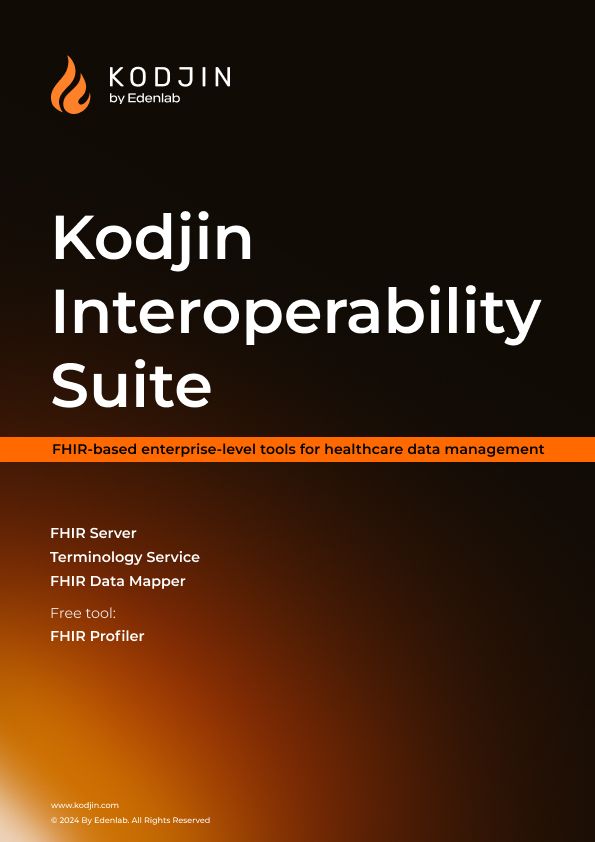Data exchange between different systems in healthcare is a complex subject. The widespread adoption of EHR systems and the digitalization of administrative processes within many healthcare organizations has resulted in large amounts of data stored on providers’ servers. But for many organizations, healthcare data remains trapped in the systems due to poor interoperability and the challenges associated with it.
By leveraging HL7 integration for effective clinical data exchange, healthcare organizations can drastically improve patient care, reduce medical errors, better coordinate care, and improve population health management. Without common data standards, the receiving system may struggle to properly interpret and utilize the data being transferred. This can cause difficulties in data exchange both within a provider organization and between providers and payers.
The inconsistent use of data standards for structuring and encoding health data can hinder information sharing between healthcare providers, laboratories, pharmacies, and payers. That’s why organizations, such as HL7 International, develop and release standards to help achieve true healthcare interoperability for all providers and other industry stakeholders.
In this article, we’ll examine HL7 integration and various health data standards that facilitate the seamless exchange of data across all healthcare systems.
What is HL7 International?
Health Level Seven International (HL7) is a leading organization in the healthcare industry, recognized as an American National Standards Institute (ANSI) accredited Standards Developing Organization (SDO).
HL7 is responsible for producing standards (sometimes called specifications, protocols, or frameworks) that improve the delivery of care, optimize workflows, reduce data ambiguity, and enhance the transfer of information among all stakeholders involved in the healthcare industry. These stakeholders include healthcare providers, government agencies, various vendors, other SDOs, and most importantly, patients.
HL7’s main goal is to promote interoperability and ensure all stakeholders within healthcare can communicate effectively and efficiently. The standards produced by HL7 lead to an overall better quality of care and increase patient safety by reducing the risk of medical errors and improving the coordination of care.
What are the primary HL7 data standards?
Over the years, HL7 has released many standards aimed at improving the standardization of data and interoperability. In this article, we’ll talk about the three primary healthcare data integration standards that have garnered widespread use in healthcare. Compliance with HL7 standards is what’s often referred to as HL7 integration.
HL7 V2
HL7’s V2 messaging, now succeeded by V3, is HL7’s first data exchange standard to become prevalent worldwide in the healthcare industry. It encompasses both structural and semantic specifications for medical communication to address the requirements of a hospital’s IT system, including clinical, administrative, financial, and logistical processes. HL7 V2 was designed to support a centralized patient care infrastructure, with less emphasis on data exchange between different systems.
According to HL7, 95% of US healthcare institutions use HL7 V2.x in their information systems, with 35 more countries that have adopted the standard to various extents.
But despite its widespread use, HL7 V2 has several shortcomings:
- It is too ambiguous and excessive in flexibility.
- Its generic nature doesn’t allow for constraints for specific use cases.
- The standard contains inconsistencies and overlaps.
- Conformance is often not specific.
- V2 requires site-specific installation parameters and coding.
To combat these limitations, HL7 developed Version 3 (V3) of the standard, which covers more specific use cases but is more complex and stricter in implementation. Unlike V2, V3 utilizes XML and distinguishes between two types of objects: messages and documents.
Clinical Document Architecture (CDA)
Clinical Document Architecture (CDA) is a standard for exchanging electronic health information based on XML markup. It provides a structured format for creating and exchanging clinical documents, such as discharge summaries, referral letters, and lab results, among others.
CDA is designed to support interoperability, enabling the exchange of information between different systems and organizations. The standard provides a consistent format for clinical information, improving the flow of information and patient care coordination while ensuring the confidentiality and privacy of patient data.
While CDA provides the semantics and encoding of clinical statements, it also has some limitations:
- It doesn’t define transmission rules.
- It’s not constrained enough to represent specific use cases of document types.
Both HL7 data integration with V2 and CDA present a steep learning curve and can be difficult to implement. For instance, the earlier version of HL7 V2 is not easily readable by humans and requires extensive training before one can start developing with it. CDA operates in read-only mode and handles large documents but lacks modularity.
Fast Healthcare Interoperability Resources (FHIR)
In response to the shortcomings of previous standards and the market’s need for a faster and easier way to rapidly exchange health data, in 2012, HL7 developed a new standard — Fast Healthcare Interoperability Resources (FHIR).
Read Also: FHIR vs. HL7
The FHIR standard is both a specification as well as an open web API. It’s based on well-known web technologies like XML, JSON, HTTP, OAuth, and REST with support for CRUD operations. This makes HL7 hospital integration easier and reduces barriers to entry, even for developers without prior healthcare IT knowledge.
The main focus of the standard is to provide a tool that can be eagerly adopted by software vendors and developers. FHIR utilized “resources” as building blocks that can be combined to cover most of the possible use cases.
Governments around the world are pushing for interoperability in healthcare to improve outcomes and reduce expenses. The ISiK law in Germany made it mandatory for hospitals to have FHIR-compatible interfaces by June 2023. In the United States, the 21st Century Cures Act mandates medical providers and IT developers facilitate patient data access via FHIR-based applications and APIs.
Read Also: FHIR Implementation in Germany
What are the benefits of HL7 standard integration?
Exhaustive data standards help bring healthcare stakeholders a step closer to achieving true EHR interoperability, be it an independent medical practice or a national-level entity. Without standards such as those published by HL7, clinicians would still be faxing and carrying paper documents everywhere. As a result, this would lead to working within disparate data silos, not having easy access to information from EHRs, and spending too much time on manual tasks.
By leveraging various data integration solutions, healthcare organizations can seamlessly integrate HL7 data from EHR systems, ensuring streamlined workflows, enhanced access to crucial information, and reduced reliance on manual tasks, thus driving true interoperability and breaking down data silos.
Let’s examine how HL7 standards integration benefits healthcare organizations:
- Data integration across all systems. Healthcare data standards enable seamless data communication between different medical systems such as EMR (Electronic Medical Record), RIS (Radiology Information System), LIS (Laboratory Information System), and PACS (Picture Archiving and Communication System), which most hospitals have now. Without well-defined data standards, exchanging information would be a long and arduous process.
- Improvements to decision-making. A faster exchange of clinical information ensures physicians can make critical decisions much faster, improve treatment outcomes, and lower morbidity rates. For example, if lab test results are quickly integrated into a hospital’s EHR system, then a list of patients with diabetes can be compiled. The provider can then determine which of these patients have uncontrolled blood sugar and schedule necessary follow-up appointments.
- Easier implementation. Since standards such as HL7 V2, CDA, and FHIR are in widespread use and have been for years, if not decades, an extensive amount of various materials can help with implementation. Health organizations don’t need to start completely from scratch to integrate HL7 data from the EHR system. This saves time, resources, and costs. Therefore, this is one of the main HL7 benefits.
- Improved compatibility and compliance. With established standards in place, you can rest assured there will be no discrepancies or violations regarding the protection and confidentiality of patient data. This will also allow for the seamless exchange of medical information with other organizations that follow the same widely recognized standards.
- Efficient medical billing and claims management. The last advantage of HL7 but not the last in importance. The use of standardized codes in medical billing has become an indispensable tool for healthcare providers. By providing a clear and concise representation of medical procedures and treatments, standardized codes simplify the billing process and help ensure claims are well-supported and accurate. This leads to increased efficiency in the billing process and reduces the time and effort required to resolve any discrepancies or denied claims.
Conclusion
Integration with HL7 standards is important in healthcare because it enables the seamless exchange of clinical and administrative data between different healthcare information systems, such as electronic health records (EHRs), laboratory systems, and radiology information systems.
This integration allows healthcare providers to access a patient’s complete medical history and test results, leading to more informed decision-making, improved patient care, and reduced medical errors. Additionally, HL7 integration supports the efficient sharing of health information between organizations, which is critical for coordinated and comprehensive care, particularly for patients with complex medical conditions.
By facilitating data exchange, HL7 data integration helps achieve the goal of a connected healthcare system and contributes to the delivery of high-quality, safe, and cost-effective healthcare.
At Edenlab, we offer HL7 FHIR integration services designed to help healthcare organizations achieve this level of data exchange and interoperability. Our services are highly customizable and flexible, ensuring we can deliver the right solution for your specific needs and requirements. Our team of experts knows how to integrate HL7 standards efficiently, effectively, and with a focus on quality.
FAQs
- Does Kodjin provide HL7 integration services?
Yes, the Kodjin Interoperability Suite supports HL7 integration based on the FHIR standard. We can provide an FHIR Server or an FHIR Facade to integrate EHR data with the HL7 FHIR standard. You can discover more about our services and HL7 integration strategies in our HL7 integration case studies.
- What is an HL7 interface in healthcare?
In healthcare, an HL7 interface integration refers to a technical communication link between two systems that use the HL7 data exchange standards, such as FHIR, HL7 V2, and CDA. An HL7 interface defines the rules for sending and receiving messages, including the structure, content, and format of the messages. This helps ensure that the data being exchanged is standardized, consistent, and understandable by all systems involved in the communication. Integration of an HL7 interface is a critical component in enabling seamless data exchange and interoperability between healthcare systems.
- Why is HL7 difficult to integrate?
There are several reasons why HL7 integration can be difficult, such as the complexity of standards, data quality, technical barriers, cost, and time. But despite these challenges, the benefits of HL7 integration, such as improved data exchange, increased efficiency, and better patient care, make it an important goal for many healthcare organizations.



